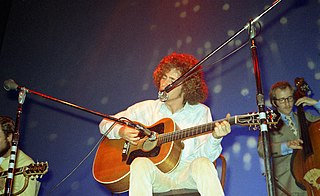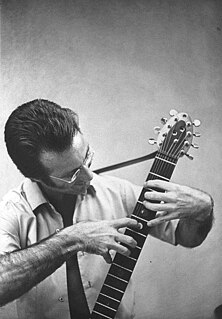Related Research Articles

Timothy Charles Buckley III was an American singer-songwriter. His music and style changed considerably through the years. Buckley began his career based in folk music, but his subsequent albums experimented with jazz, psychedelia, funk, soul, the avant-garde, and an evolving voice-as-instrument sound. He died at the age of 28 from a heroin and morphine overdose, leaving behind sons Taylor and Jeff.

Starsailor is the sixth studio album by Tim Buckley, released on Herb Cohen's Straight Records label in November 1970. Starsailor marks the moment Buckley's folk rock origins became invisible as he fully incorporated jazz rock and avant-garde styles into his music. Although it alienated elements of his fanbase upon release, it also contains his best known song, "Song to the Siren". This more accessible song was written much earlier than Starsailor's newer material, originally in a more traditional folk arrangement, as shown on the later released compilation album Morning Glory: The Tim Buckley Anthology. Bunk Gardner, a former member of the Mothers of Invention, joined Buckley's normal band to record the album. Also, Buckley began working again with lyricist Larry Beckett, after a three-album hiatus.

Emmett Chapman was an American jazz musician best known as the inventor of the Chapman Stick and maker of the Chapman Stick family of instruments.

Curtis Roy Boettcher, sometimes credited as Curt Boetcher or Curt Becher, was an American singer, songwriter, arranger, musician, and record producer from Wisconsin. He was a pivotal figure in what is now termed "sunshine pop", working with the Association, the Millennium, Sagittarius, Paul Revere and the Raiders, Tommy Roe, Elton John, Gene Clark, Emitt Rhodes, Tandyn Almer, the Beach Boys, and others.

Larry Eugene Carlton is an American guitarist who built his career as a studio musician in the 1970s and 1980s for acts such as Steely Dan and Joni Mitchell. He has participated in thousands of recording sessions, recorded on hundreds of albums in many genres, for television and movies, and on more than 100 gold records. He has been a member of the jazz fusion group the Crusaders, the smooth jazz band Fourplay, and has maintained a long solo career.
Charles Walter Rainey III is an American bass guitarist who has performed and recorded with many well-known acts, including Aretha Franklin, Steely Dan, and Quincy Jones. Rainey is credited for playing bass on more than 1,000 albums, and is one of the most recorded bass players in the history of recorded music.

Blue Afternoon is the fourth studio album by Tim Buckley, released in November 1969. It is Tim Buckley's first self-produced record and his debut for Herb Cohen and Frank Zappa's Straight record label. This was Buckley's fourth album after Tim Buckley, Goodbye and Hello, and Happy Sad. Blue Afternoon used the same group of musicians as Happy Sad, with the inclusion of drummer Jimmy Madison.

Earl Slick is a guitarist best known for his collaborations with David Bowie, John Lennon, Yoko Ono and Robert Smith. He has also worked with other artists including John Waite, Tim Curry and David Coverdale, in addition to releasing several solo recordings, and two records with Phantom, Rocker & Slick, the band he formed with Slim Jim Phantom & Lee Rocker.

Goodbye and Hello is the second album by Tim Buckley, released in August 1967, recorded in Los Angeles, California, in June of the same year.

Happy Sad is the third album by American singer-songwriter Tim Buckley, released in April 1969. It was recorded at Elektra Sound Recorders in Los Angeles, California and was produced by former Lovin' Spoonful members Zal Yanovsky and, coincidentally, his subsequent replacement Jerry Yester. It marked the beginning of Buckley's experimental period, as it incorporated elements of jazz that he had never used before. Many of the songs here represent a departure from the binary form that dominated much of his previous work. The sound of the album is characterized by David Friedman's vibraphone, an instrument which gives the album a more relaxed tone than Buckley's earlier work. The songs are much longer than on previous releases and this style continued through to later works. The vocals on the album are more drawn out than earlier performances and this represents the beginning of Buckley using his voice like an instrument. The lyrics on Happy Sad represent a change as Buckley stopped working with Larry Beckett, his lyricist on the two previous albums Tim Buckley and Goodbye and Hello, and began writing the lyrics himself. Buckley's self-penned efforts stand in contrast to Beckett's occasionally political and literary-style work. Buckley would also go on to author all his own material on the following two albums.

Tim Buckley is the debut album by Los Angeles based singer-songwriter Tim Buckley, released in October 1966. Most of the songs on it were co-written by Buckley and Larry Beckett while they were in high school. It was recorded at Sunset Sound in Los Angeles, California.

Lorca is the fifth studio album by singer-songwriter Tim Buckley, his fifth since his debut in 1966. It was named after Spanish poet Federico Garcia Lorca, and was recorded simultaneously with Blue Afternoon, though notably different in style. It was one of Buckley's two avant-garde albums, and explored some sounds and ideas he had not previously used. Also importantly, it was an attempt to break away from more traditional and prevalent pop music songwriting styles, such as the verse/chorus binary form, that Buckley had explored in the earlier parts of his career.

Sefronia is the eighth album by singer-songwriter Tim Buckley, released in September 1973.

Dream Letter: Live in London 1968 is a live album by Tim Buckley. The album was recorded in Queen Elizabeth Hall, London, England on October 7, 1968. Due to a lack of available funds Buckley was unable to tour with regular bass player John Miller and conga player Carter "C.C." Collins. The concert instead features bassist Danny Thompson, guitarist Lee Underwood and vibraphone player David Friedman.

Live at the Troubadour 1969 is a live album by Tim Buckley. The album was recorded at the Troubadour in Los Angeles, September 3 & 4, 1969.
Judith Anne "Judy" Henske was an American singer and songwriter, dubbed "the Queen of the Beatniks" by producer Jack Nitzsche. Initially performing in folk clubs in the early 1960s, her performances and recordings embraced blues, jazz, show tunes, and humorous material. Her 1963 recording of "High Flying Bird" was influential on folk-rock, and her 1969 album Farewell Aldebaran, with husband Jerry Yester, was an eclectic "fusion of folk music, psychedelia, and arty pop".
Mark Warren Spoelstra was an American singer-songwriter and folk and blues guitarist.

Essential Rarities is a compilation album by the Doors, originally released as part of the boxed set The Complete Studio Recordings in 1999, but reissued in 2000 as a single CD, containing studio cuts, live cuts and demos taken from the 1997 The Doors: Box Set.
Lawrence Benjamin Bunker was an American jazz drummer, vibraphonist, and percussionist. A member of the Bill Evans Trio in the mid-1960s, he also played timpani with the Los Angeles Philharmonic orchestra.
Mike Melvoin was an American jazz pianist, composer, and arranger. He served as chairman and president of The Recording Academy and worked as a prolific studio musician, recording with Frank Sinatra, John Lennon, The Jackson 5, Natalie Cole, and The Beach Boys. Melvoin was nominated for the 2003 Grammy Award for Best Jazz Instrumental Solo for "All or Nothing at All" from his album It's Always You.
References
- 1 2 Chadbourne, Eugene. "Lee Underwood". AllMusic. Retrieved October 7, 2018.
- 1 2 3 4 5 "Interview: Lee Underwood". Hit Channel. April 11, 2012. Retrieved October 2, 2019.